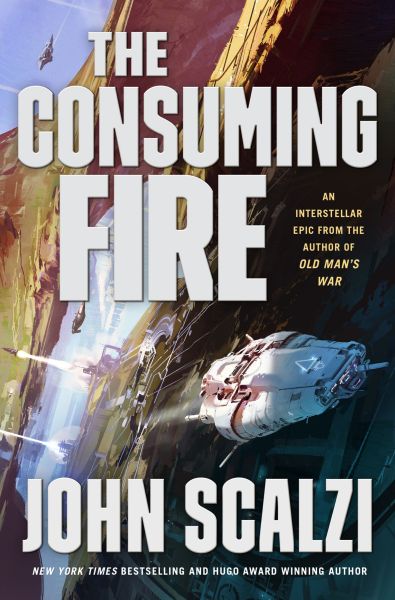This Very Hour
The Consuming Fire (The Interdependency, volume 2)
By John Scalzi

9 Feb, 2021
2018’s The Consuming Fire is the middle volume in John Scalzi’s Interdependency trilogy.
Faced with the impeding collapse of the Flow, the phenomena that facilitates the faster-than-light travel on which all the worlds of the Interdependency rely, Cardenia Wu-Patrick AKA Emperox Grayland II is determined to urge her subjects to recognize the impending crisis and consider ways to mitigate it. To this end, she uses her status as church figurehead to begin uttering prophecies of the Doom Which Is to Come.
This succeeds in convincing a number of powerful people that Grayland II is quite mad.
To a degree, those who embrace the Grayland II is mad explanation (as opposed to Grayland II is cynically exploiting a church whose foundations are cynical justification for the Interdependency) do so for self-serving reasons. The Countess Nohamapetan is somewhat peeved at Grayland II for having the Countess’ daughter Nadashe arrested over some trifling matter of treason, murder, attempted murder, and other crimes. Various Wus would quite like to be the next Emperox.
This is good news for Grayland II, because there is more than one self-serving agenda at work and until the plotters can agree on details, they hold off on their grand coup. This gives Grayland II time she desperately needs.
Among the Interdependency’s many deficits: a near lack of scientists specializing in Flow collapse. In fact, one could fit all of them into one room. Because the previous Emperox suppressed information about the collapse to avoid panic—Nobody Wants a Panic: Justifying Terrible Public Policy Across Millennia!—the only Flow scientists who have conferred with each other have been members of the Claremont family. Now, finally, a Claremont — Marce Claremont — meets with fellow researcher Hatide Roynold to compare notes.
Hatide’s Flow model is flawed. So, to a lesser extent, is Marce’s. The Flow will collapse but not as completely as the Claremont model predicted. The Flow will re-establish itself but not within the immediate time frame the Roynold model indicated.
The Claremont-Roynold Synthesis reveals a previously unknown fact: there is a new Flow connection to Dalasýsla, lost to the Interdependency eight centuries before. Time for a side-quest to the isolated system before the connection collapses, in search of data on the Flow, the consequences of Flow collapse, and quite unexpectedly, long-forgotten history.
~oOo~
One of the unintended consequences of the plot is indirect contact with another interstellar community. This distant community is (or at least was) a monarchy. The degree of faith American SF authors have in kingdoms and empires, or at least the paucity of competing models of government in US SF, astounds me.
This volume makes clear that the Interdependency is stupendously stagnant. The context justifies this. The whole thing is an exercise in rent extraction; innovation might undermine the governing business models. As well, the Interdependency’s population is small and scattered across forty-seven systems.
On that note, the novel feels like there should be a lot more people involved in running the Interdependency than there actually are. I don’t often say this, but the setting needs a larger bureaucracy. The cast of people who make decisions is small enough that it would be easy enough to adapt this as a stage play, aside from the trifling issue that COVID-19 would then burn through the audience like the virgin field pandemic that it is.
Middle volumes in trilogies can be problematic; they cannot resolve the greater issues or what’s the third volume for? There is therefore a temptation to pad the novel with wheel-spinning. There’s also a reliable fix: if the characters threaten to extricate themselves too quickly from impending doom, just release more wolves. Scalzi opts for this second approach. There are dire complications galore.
Unsurprisingly for a John Scalzi novel, this is a John Scalzi novel. Despite a setting more than a thousand years (and many light-years) distant from our time and place, the Interdependency characters could hale from modern-day Ohio. The patter is snappy — pity neither William Powell nor Myrna Loy are currently taking roles — and a number of the characters are sufficiently sympathetic that readers will care what happens to them, which is not always the case with fantasy and SF novels. It’s all very on-brand, so you liked previous works by this author, you should like this one.
The Consuming Fire is available here (Amazon US), here (Amazon Canada), here (Amazon UK), here (Barnes & Noble), here (Book Depository), and here (Chapters-Indigo).
